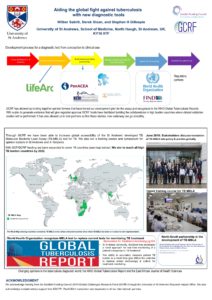 PI: Dr Wilber Sabiiti
PI: Dr Wilber Sabiiti
According to the World Health Organisation’s Global Tuberculosis Report 2017, tuberculosis (TB) is the leading cause of death from infectious disease, with a higher incidence than HIV/AIDS. To tell whether a patient is responding or to test the effectiveness of new TB drugs, one must be able to count the number of live Mycobacterium tuberculosis from the patient’s lungs. The current culture-based tests take up to eight weeks and require expensive containment facilities beyond the means of most health facilities in regions where the disease is common.
Researchers at the School of Medicine have developed a new biomarker for TB, the Molecular Bacterial Load Assay (MBLA) test that can diagnose and quantify live TB in four hours. The TB-MBLA field evaluation, in large-scale trials in four African centres, demonstrated that the tests have sensitivity similar to TB liquid culture, a gold-standard for TB diagnosis, give a quantitative measure of infection and require no additional result tests. The researchers are working with LifeArc, a product development charity, towards CE marking, the crucial step to allow the test to be used for patient diagnosis. The team have been working with stakeholders from 16 countries in Africa, Asia and Europe to explore best methods to translate the test into clinical practice. In WHO’s Global Tuberculosis Report 2018, the MBLA was included as a promising new test for treatment monitoring. 
